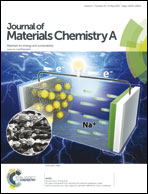Copper phosphide modified cadmium sulfide nanorods as a novel p–n heterojunction for highly efficient visible-light-driven hydrogen production in water†
Abstract
Developing efficient photocatalysts made of earth-abundant elements for hydrogen (H2) production from water is considered to be a key pathway for future clean energy supply. Herein we report for the first time that p-type copper phosphide (Cu3P) can be an efficient promoter to improve photocatalytic H2 production from water when loaded on n-type cadmium sulphide nanorods (CdS NRs). The formation of a p–n junction in Cu3P/CdS NRs leads to fast charge transfer and enhanced photocatalytic activity under visible light irradiation. Under optimal conditions, the H2 evolution rate was as high as ∼200 μmol h−1 mg−1 (λ > 420 nm) and the apparent quantum yield at λ = 450 nm was ∼25% in water.


 Please wait while we load your content...
Please wait while we load your content...